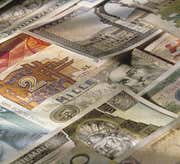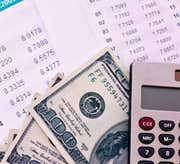Monte Carlo Simulation
In its most basic form, the Monte Carlo simulation seeks to simulate real-world outcomes by showing a range of outcomes for a given variable set. For example, in the casino game roulette, Monte Carlo could simulate where the roulette ball lands for 10 consecutive rounds.
Excel's "RAND" function can generate random numbers in a given sample set. By simply setting the formula equal to RAND, Excel will generate a random number between 0 and 1. To detail the range of possible outcomes, Microsoft states that around 25% of the time, a number less than or equal to 0.25 should occur, and around 20% of the time the number will be at least 0.90, which is logical and intuitive, given the outcomes are restricted to such a tight range.
Excel offers a number of other ways to simulate random variable outcomes. For instance, the "NORMINV" function returns the inverse of the normal distribution for a specified mean and standard deviation.
Black-Scholes Formula
The valuation of stock options can be incredibly complex and math-intensive. Excel offers a number of ways to price stock options, including the more plain vanilla puts and calls. The Black-Scholes formula is the most widely adopted measure for valuing an option. Its inputs are as follows:
S=Today's stock price
t=Duration of the option (in years)
X=Exercise price
r=Annual risk-free rate (This rate is assumed to be continuously compounded.)
σ=Annual volatility of stock
y=Percentage of stock value paid annually in dividends
Excel doesn't have an actual formula employing Black-Scholes, but there are add-ins, as well as additional outside files that can be downloaded to help the user calculate the value of a put or call option.
Guide To Excel For Finance: Conclusion
-
 Investing
InvestingMultivariate Models: The Monte Carlo Analysis
This decision-making tool integrates the idea that every decision has an impact on overall risk. -
 Investing
InvestingHow to use Monte Carlo simulation with GBM
Learn how to estimate risk with the use of a Monte Carlo simulation to predict future events through a series of random trials. -
 Investing
InvestingCreate a Monte Carlo Simulation Using Excel
How to apply the Monte Carlo Simulation principles to a game of dice using Microsoft Excel. -
 Investing
InvestingWhy Your Investment Growth Calculator May Be Wrong
Many simple investment growth calculators fall short, so here's one you should use instead. -
 Small Business
Small BusinessDisadvantages of Stock Simulators
Stock simulators enable one to practice trading, but they have some disadvantages that you should be aware of before transitioning to actual trading. -
 Personal Finance
Personal FinanceStock Market Simulators: Play Your Way to Profits
Learn more about online stock simulators, and how they make learning about stocks as fun and easy as playing a game. -
 Trading
TradingHow To Convert Value At Risk To Different Time Periods
Volatility is not the only way to measure risk. Learn about the "new science of risk management". -
 Investing
InvestingSimulator How-To Guide
A stock simulator allows you to use fake money on real stocks. Learn how to buy a stock watch the result.



